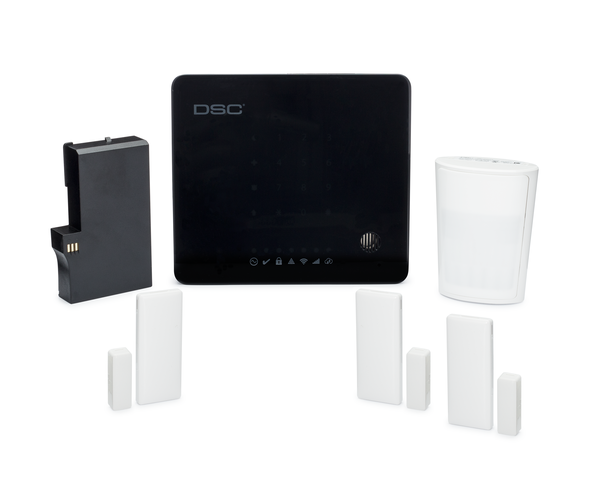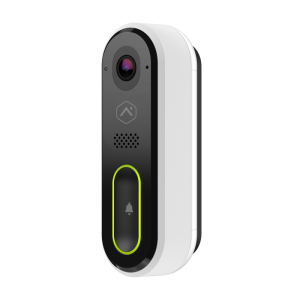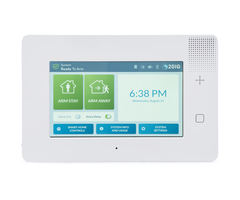With ISC West 2021 quickly approaching, we thought it would be nice to take a quick look at various security manufacturers to speculate about what they might be presenting. Keep in mind, this is purely speculation. None of this is guaranteed, it's just our guess as what we might see.
Before you read about the various security and smart home automation offerings that we might see, make sure to check out our earlier post on the ISC West 2021 Health and Safety Guidelines, if you haven't already. Remember that this year's ISC West runs from Monday, July 19th through Wednesday, July 21st at the Sands Expo Center in Las Vegas, NV. With that out of the way, let's begin discussing some manufacturers.
Resideo
Resideo will certainly want to showcase its new system, the PROA7PLUS. We would expect to see both the Honeywell Home PROA7PLUS and the virtually identical Resideo PROA7PLUSC showcased prominently at ISC West 2021. You will also likely see its accompanying hardware, including the PROLTE-A and PROLTE-V Communicators, the PROTAKEOVER Legacy Receiver Module, and the PROSIX Series Encrypted Wireless Sensors. All of this aforementioned equipment is already available for purchase.

As for new products, we would be surprised if we didn't see Resideo releasing a new lineup of security cameras, perhaps under the Honeywell Home brand. With the Honeywell IPCAM-OC1 Outdoor Camera being discontinued, the selection of Total Connect 2.0 Cameras is pretty weak compared to the selection of Alarm.com Cameras. As such, a user getting security cameras as part of their system is more likely to choose an Alarm.com System than a Resideo System that is being used with Total Connect 2.0. We're sure Resideo wants to change that, so it would be disappointing if we don't see some new Resideo Cameras.
Lastly, we have heard rumors of a new hardwired system that would essentially replace the Honeywell VISTA Series. This lineup of wired panels is rumored to be named the Honeywell Home PROH8PLUS, and it would be a fully hybrid system able to support both hardwired sensors and wireless sensors, possibly using the PROTAKEOVER Module Legacy Receiver. While there's nothing inherently wrong with VISTA Alarm Panels, we might see Resideo updating their technology a bit, and bringing the hardwired selection lineup to the next level.
Nortek & 2GIG
From what we can tell, Nortek is very pleased with their 2GIG Edge Security System, and it's a fair bet that that 2GIG Edge Alarm Panel will be the main highlight of the 2GIG and Nortek Booth at ISC West 2021. And it's rightfully so, as the Edge is a highly advanced alarm panel with great features like facial recognition and Bluetooth disarming. What remains to be seen if Nortek will decide to roll-out a lineup of 2GIG Edge-exclusive encrypted sensors, perhaps to break away from the existing 2GIG eSeries Sensors that work with the Edge and the older GC2e and GC3e. However, we haven't actually heard anything about new 2GIG Edge Sensors, so that is just pure speculation. That being said, you can bet on 2GIG to heavily feature the 2GIG Edge Alarm System in their booth. If you haven't seen it an action yet, then ISC West 2021 figures to be a great opportunity. The 2GIG Edge and its accessories are currently available for purchase from Alarm Grid.

Qolsys
Qolsys has been secretly working away on some new alarm panels, and we figure ISC West 2021 to be right opportunity for Qolsys to unveil them to the public. The company needs to make a big splash to keep up with household names like Honeywell Home and 2GIG. We can expect to see the new Qolsys Budget Panel, the Qolsys IQ Hub, which we have been expecting for quite some time.

This may also be the chance for Qolsys to unveil their big new flagship alarm panel, the Qolsys IQ Panel 4. We are expecting the IQ Panel 4 to be a tremendous juggernaut in the home security industry, as the new alarm system will boast a Snapdragon Chipset running Android 9 Software, and come complete with an 8MP front-facing camera, all-new lifestyle automation pages, and oodles of great features. There's a chance Qolsys might be secretive and keep the IQ Panel 4 tucked away, but we would be pretty sad if we don't get to see it at ISC West 2021. We are hopeful that the Qolsys IQ Panel 4, Qolsys IQ Hub, and Qolsys IQ Router will be made available later this year.
DSC
Digital Security Controls (DSC) has been at the forefront of Canadian Home and Commercial Security for years. But now that both DSC and Qolsys are under the Johnson Controls banner, we may see considerably less of the DSC brand out in the limelight. As security systems are being made "sexier" and flashier to fit-in with a modern home, a bulky wired alarm system like the DSC PowerSeries NEO just isn't suitable for most residential applications. We don't expect DSC to be completely absent from ISC West 2021, but don't be surprised if Johnson Controls is putting Qolsys out on center stage, while DSC may remain more in the background as more of a commercial security option. The PowerSeries NEO and the existing DSC Iotega are both candidates to be featured in ISC West 2021. We have not yet received any word on possible "new" DSC equipment that may be featured.

Alarm.com
Alarm.com always has a prominent showing at ISC West, and we don't expect this year to be any different. However, we aren't really sure what to expect from Alarm.com, if anything new. It's possible that Alarm.com might try to make ISC West 2021 more of a quiet showing. It's likely that the Alarm.com Smart House will return, allowing users to interact with the latest smart home automation and video surveillance offerings from Alarm.com. The ADC platform strives to be a leader in terms of home automation, and they will likely use this ISC West to showcase their complete array of offerings and how their equipment can be used together to create a complete smart home. We are also regularly pleased with all the Alarm.com Video Camera offerings, so it's fair to expect their cameras to make an appearance. We aren't necessarily expecting any new cameras, but we definitely anticipate seeing great devices like the ADC-V523, ADC,V622-WELL, ADC-V723, and ADC-VDB770 Doorbell Camera.

Z-Wave Alliance
You can always bet on seeing the Z-Wave Alliance tucked away in the back corners of the ISC West Showroom Floor. Z-Wave wireless communication has secured itself as the leading protocol in smart home automation, and it continues to dominate for good reason. ISC West 2021, figures to be a huge opportunity for Z-Wave 700-Series Technology to really present itself to the public and showcase its rich capabilities. Z-Wave 700-Series, also being called Z-Wave Plus V2, promised extended wireless range, and a longer battery life of at least ten (10) years. Z-Wave Plus V2 sensors are also required to be built on the Z-Wave S2 Security Protocol, thereby making them more secure than most Z-Wave 500-Series devices.
Of course, the Alarm Grid team will be returning to ISC West 2021, ready to post about the latest security offerings from all the major brands. Be sure to keep-up with the Alarm Grid Blog if you can't make it to ISC West 2021 yourself. We will let you know the latest news for Resideo, Honeywell Home, 2GIG, Qolsys, and more as we attend the event in Las Vegas, NV. Stay tuned for more ISC West 2021, especially as we get closer to the even on July 19th through July 21st. We're super excited, so get ready for more content coming soon.










 If you aren't familiar with Alarm.com System Enhancement Modules (SEMs), they are basically
If you aren't familiar with Alarm.com System Enhancement Modules (SEMs), they are basically 
 We announced earlier this month that the
We announced earlier this month that the